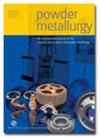Influence of the SiC content and sintering temperature on the microstructure, mechanical properties and friction behaviour of sintered self-lubricating composites
IF 1.9
4区 材料科学
Q2 METALLURGY & METALLURGICAL ENGINEERING
引用次数: 27
Abstract
This work reports the development of a new, low-friction coefficient combined with high mechanical strength and scuffing resistance of self-lubricating composite produced by powder injection moulding process and the recently introduced plasma-assisted debinding and sintering process. We present and discuss the effect of sintering temperature and SiC content on the microstructure, mechanical and friction properties. Three different temperatures (1100,1150, 1200°C) and six different SiC contents (0–5%) were analysed. SiC content had a paramount role on the microstructure, mechanical and friction behaviour. Sintering temperature had almost no effect on the friction coefficient. However, the sintering temperature strongly influences scuffing resistance. Raman spectra obtained in the central region of the wear scar indicate the presence of turbostratic two-dimensional graphite. The misorientation between graphene planes and the increase in interlamellae distance may induce a low interaction between these atomic planes and are, probably, the origin of the low-friction coefficient.SiC含量和烧结温度对烧结自润滑复合材料显微组织、力学性能和摩擦性能的影响
本文报道了一种新的低摩擦系数、高机械强度和耐磨损的自润滑复合材料的发展,这种复合材料是通过粉末注射成型工艺和最近引入的等离子辅助脱脂和烧结工艺生产的。讨论了烧结温度和SiC含量对复合材料显微组织、力学性能和摩擦性能的影响。分析了三种不同的温度(1100,1150,1200℃)和六种不同的SiC含量(0-5%)。SiC含量对材料的微观结构、力学性能和摩擦性能有重要影响。烧结温度对摩擦系数几乎没有影响。而烧结温度对耐磨损性影响较大。在磨损痕中心区域获得的拉曼光谱显示了涡层二维石墨的存在。石墨烯平面之间的取向错误和层间距离的增加可能导致这些原子平面之间的相互作用较低,这可能是低摩擦系数的来源。
本文章由计算机程序翻译,如有差异,请以英文原文为准。
求助全文
约1分钟内获得全文
求助全文
来源期刊

Powder Metallurgy
工程技术-冶金工程
CiteScore
2.90
自引率
7.10%
发文量
30
审稿时长
3 months
期刊介绍:
Powder Metallurgy is an international journal publishing peer-reviewed original research on the science and practice of powder metallurgy and particulate technology. Coverage includes metallic particulate materials, PM tool materials, hard materials, composites, and novel powder based materials.
 求助内容:
求助内容: 应助结果提醒方式:
应助结果提醒方式:


